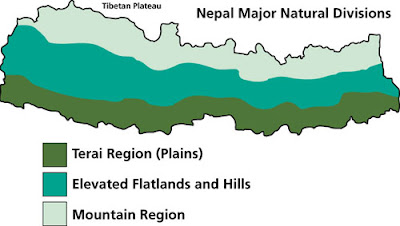 |
| The Hilly region is situated in the central part of the country. |
The Hilly region is situated in the central part of the country. It spreads from Mechi in the east to Mahakali in the west. It has high hills and rocks. There are certain valleys surrounded by hills from all sides. Kathamndu, Phkhara, Surkhet, Dang-Deokhuri, etc. are such valleys. The hilly region lies at a fairly high altitude. So this region has a moderate type of climate. It is neither too cold, nor too hot. There is heavy rainfall from June to September. It also receives winter rain. Moreover, Pokhara valley gets the heaviest rainfall in Nepal.
SOCIAL LIFE
Food: Rice is the main food of the people of this region. Some people also eat bread. They eat meat, eggs, milk, curd, butter, ghee, etc. which they get from domestic animals.
Costume: Male members wear Daura, Suruwal, coat and cap, female members wear cholo, fariya and patuka. Men in the town areas wear pants, shirt and coat, and women wear sari and blouse.
Housing: Most of the houses in this region are made of stone and clay. They have thatched roofs. There are single-storey houses. In the town areas, multi-storey buildings are also seen.
Health: Government has established Health Centres and Health Posts in various places of this region. In the town areas, there are many big hospitals. Kathmandu, the capital of the country, has many large hospitals. Patients from all over the country come to benefit themselves of the treatment available in the capital town.
Education: The hilly region is the centre of education in the country. The centres of education are: Kathmandu, Pokhara, Tansen, Dhankuta, Birendranagar, Banepa, etc. There are many Primary and Secondary Higher Secondary Schools, Campuses and Universities in this region.
ECONOMIC LIFE
Agriculture: Agriculture is the main occupation of the people living in this region. They cultivate maize, wheat, rice, millet, soyabeans, etc. Rice and wheat cultivated in the valleys and river basins. Other crops are cultivated in the hills. The people also rear domestic animals and grow fruits and vegetables.
Industry: Many industries are set up in this region. There are cement, bricks and tiles, textile, biscuit, leather and shoes, beer and wine and other industries in the Hilly region. In addition to these industries, there are Industrial Estates in Balaju, Patan, Bhaktapur and Pokhara. There are various cottage and small-scale industries as well.
Trade: In this region, some people earn their living from trade and business. Kathmandu is the centre of trade and business. Other business centres are Dhankuta, Pokhara, Tansen, Ghorahi, Surkhet, etc.
Some Important Places in the Hilly Region
Kathmandu (Kantipur): It is the capital and the biggest city of the country. It is in the Kathmandu district of the Bagmati Zone. The Parliament and head offices of all offices are located here. Basantapur palace is another important place for its Hanuman Dhoka and the ‘Kasthamandup’ from which the name Kathmandu is derived. The holy place of Hindus-the temple of Pashupatinath is in Kathmandu. Swayambhunath, the sacred place of Buddhist pilgrims is also in Kathmandu. It is the treasure house of Nepalese art, culture, history and traditions.
Bhaktapur (Bhadgaon): Bhadgaon is the ancient name of modern Bhaktapur. It is to the east of Kathmandu. It is in Bhaktapur district of Bagmati zone. It is one of the oldest and the third biggest town in the valley. It is famous for Nepalese art and architecture. Nyatapol, the temples of Bhairavnath and Dattatraya are some of its most attractive objects. The main occupations of the people of Bhaktapur are agriculture and trade. The people are expert in weaving. The black caps prepared here are known all over the country by the name Bhadgaunle Topi (Bhadgaon’s Cap). The people of this town are expert in making earthen pots.
Patan (Lalitpur): It is located in the Lalitpur district of Bagmati zone. It lies to the south of Kathmandu. It is also famous for Nepalese art and craft. Some of the eye-catching objects of Patan are the temples of Lord Krishna, Minnath, Machchhendranath and Buddhist Stupas. The Patan Industrial Estate has been manufacturing different items for the last few years.
 Pokhara: Pokhara is situated in the Kaski district of Gandaki zone. It is the headquarters of the Western Development Region, Gandaki zone and Kaski District. There are several lakes in Pokhara, like Fewa, Rupa, Begnas, etc. which enrich the beauty of the place. At the Fewa lake itself, there is a temple of Barahi. Another significant site is the temple of Bindyabasini. Pokhara is famous for its natural beauty. Machhapuchhre, Dhaulagiri, Annapurna mountains are seen very clearly from Pokhara. Mahendra Cave, Chamero Gupha, David Falls, etc. are other attractive places of Pokhara. The beautiful scenery of Seti river is another eye-catching object. For all these reasons, Pokhara has become the centre for tourists of different countries.
Pokhara: Pokhara is situated in the Kaski district of Gandaki zone. It is the headquarters of the Western Development Region, Gandaki zone and Kaski District. There are several lakes in Pokhara, like Fewa, Rupa, Begnas, etc. which enrich the beauty of the place. At the Fewa lake itself, there is a temple of Barahi. Another significant site is the temple of Bindyabasini. Pokhara is famous for its natural beauty. Machhapuchhre, Dhaulagiri, Annapurna mountains are seen very clearly from Pokhara. Mahendra Cave, Chamero Gupha, David Falls, etc. are other attractive places of Pokhara. The beautiful scenery of Seti river is another eye-catching object. For all these reasons, Pokhara has become the centre for tourists of different countries.
Gorkha: Gorkha is a historical place. It is in the Gorkha district of Gandaki zone. It is the place where King Prithvi Narayan Shah was born. It was the capital of Garkha kingdom in ancient times. The famous Gorakhnath temple and the Gorkha Palace are the most attractive objects of Gorkha. The Manakamana temple which is visited regularly by large numbers of Hindu pilgrims lies near Gorkha.














